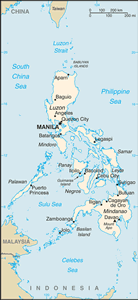The Geography of Philippines
The Geography of Philippines
Philippine Geography
Location: Southeastern Asia, archipelago between the Philippine Sea and the South China Sea, east of Vietnam
Geographic coordinates: 13 00 N, 122 00 E
Map references: Southeast Asia
Area: total: 300,000 sq km land: 298,170 sq km water: 1,830 sq km
Area - comparative: slightly larger than Arizona
Land boundaries: 0 km
Coastline: 36,289 km
Maritime claims: territorial sea: irregular polygon extending up to 100 nm from coastline as defined by 1898 treaty; since late 1970s has also claimed polygonal-shaped area in South China Sea up to 285 nm in breadth exclusive economic zone: 200 nm continental shelf: to depth of exploitation
Climate: tropical marine; northeast monsoon (November to April); southwest monsoon (May to October)
Terrain: mostly mountains with narrow to extensive coastal lowlands
Elevation extremes: lowest point: Philippine Sea 0 m highest point: Mount Apo 2,954 m
Natural resources: timber, petroleum, nickel, cobalt, silver, gold, salt, copper
Land use: arable land: 19% permanent crops: 16.67% other: 64.33% (2005)
Irrigated land: 15,500 sq km (2003)
Natural hazards: astride typhoon belt, usually affected by 15 and struck by five to six cyclonic storms per year; landslides; active volcanoes; destructive earthquakes; tsunamis
Environment - current issues: uncontrolled deforestation especially in watershed areas; soil erosion; air and water pollution in major urban centers; coral reef degradation; increasing pollution of coastal mangrove swamps that are important fish breeding grounds
Environment - international agreements: party to: Biodiversity, Climate Change, Climate Change-Kyoto Protocol, Desertification, Endangered Species, Hazardous Wastes, Law of the Sea, Marine Dumping, Ozone Layer Protection, Ship Pollution, Tropical Timber 83, Tropical Timber 94, Wetlands, Whaling signed, but not ratified: Air Pollution-Persistent Organic Pollutants
Geography - note: the Philippine archipelago is made up of 7,107 islands; favorably located in relation to many of Southeast Asia's main water bodies: the South China Sea, Philippine Sea, Sulu Sea, Celebes Sea, and Luzon Strait


